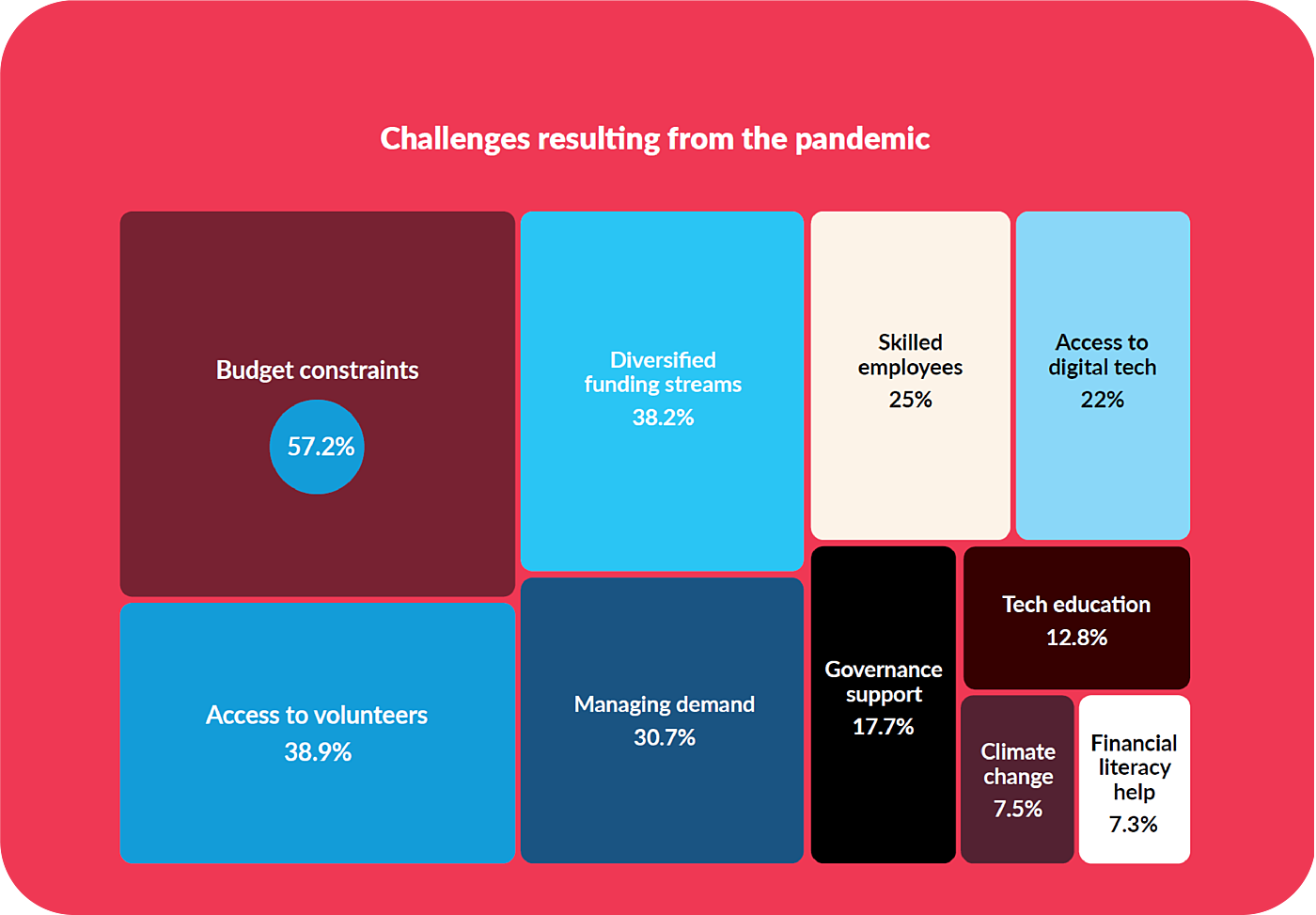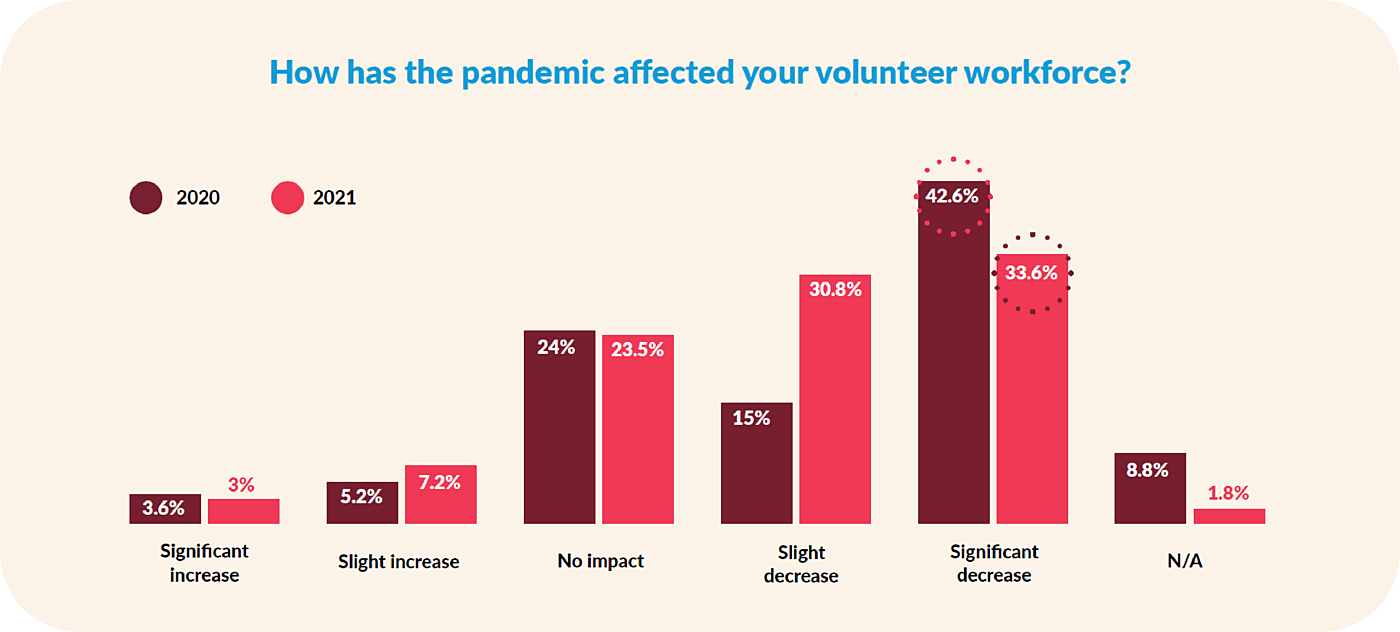Volunteering is in crisis: mounting a response

Not-for-profit organisations across Australia are experiencing a sharp decline in volunteering, according to Our Community’s recent COVID-19 Community Sector Impact Survey.
This is bad news for the country. And if you’re one of the 64% of Australian not-for-profits that is experiencing a decline in volunteers, it’s also very bad news for you (worse still if you’re one of the 52% of organisations that is also experiencing more demand for services).
Community sector leaders – board and committee members, CEOs and other senior leaders – need to act now to ensure your organisation’s viability is not threatened by this shift.
The Institute of Community Directors Australia (ICDA) recommends you undertake an urgent audit of your operations to quickly assess your level of risk and, if necessary, start to mount a response.
Start with these discussion points.
- The COVID-19 pandemic may well have put the final nail in the coffin of volunteering-as-we-knew-it. As lockdowns spread across the country, a large chunk of traditional volunteering evaporated overnight. A total of 81% of respondents to ICDA’s 2021 survey said the pandemic had affected their ability to manage and recruit volunteers.
- Volunteering numbers have been declining in Australia since 2010. This decline is confirmed anecdotally and in several academic and industry studies, including those conducted by the Australian Bureau of Statistics, Volunteering Australia, and ICDA.
- There is no reason to believe that volunteering numbers will return even to the state of decline they were in before the pandemic. Many commentators believe that the pandemic has just provided a final push to a system that has been becoming increasingly rickety for a decade.
- Social and demographic shifts identified as factors in the downturn in volunteering include
- a decline in organised religion
- a shift to two-job families (leaving everyone with less time for voluntary activities)
- people partnering later, having children older, having increased difficulty buying land; and therefore potentially being less invested in the local community
- online activities replacing face-to-face interaction
- a shift in expectations related to volunteering structures and rewards.

Taking stock
As a leader, it’s your responsibility to understand how exposed your organisation is to the volunteer downturn. Here are some questions that may help you clarify your risk.
- Setting aside any downturn since the onset of the pandemic, how many EFT hours does your volunteer workforce contribute to your organisation per day/week/month/year?
- What’s the dollar value of your volunteer workforce, at roughly $25 an hour? How does that compare with what you spend on your paid workforce?
- How many volunteers do you have on your books currently? How do your numbers now compare with July 2019 (before the onset of the pandemic)? What is the percentage increase/decline?
- What would be the effect on your organisation if 10% of volunteers who left during the pandemic did not return? What about 50%? What about 90%?
- Take a look at your organisation’s long-term volunteering trends. Plot the numbers year-on-year since 2010. What does the graph look like?
- How would your organisation be affected by a continuation of that longer-term trend?
- What tasks and roles are carried out by volunteers in your organisation? Which areas of the organisation (if any) are most heavily reliant on volunteers, and would be most affected if the trends identified above played out?
- What percentage of your volunteer workforce could be described as active volunteers? What’s the average length of time since your volunteers last contributed some hours to your organisation?
- What is the demographic breakdown of your volunteer workforce, according to gender, age, cultural and educational backgrounds, geographic location? Are you more reliant on some groups of people than others? Have your recruitment and retention strategies taken account of these factors?
- Who are your key volunteers? What do they do? What would be the impacts if they suddenly disappeared? Who would replace them? How likely are they to keep volunteering over the next one, three and five years?

Mounting a response
If your organisation is heavily reliant on volunteers, it’s quite likely that you will need to radically change your systems and practices. It’s imperative that you consider your organisation’s immediate and longer-term response to the downturn.
Each organisation’s situation will be different; what works for your organisation will not work for another. But here are some conversation starters that might help you move off the starting blocks.
Get your house in order
The best time to put in place good volunteer management systems was 10 years ago. The second best time is right now.
- How good are your records? If you can’t answer all or most of the questions above, you need better volunteer records systems.
- Who’s in charge of your volunteers? Are they provided with enough resourcing (time, training, facilities, equipment, software, management support) to do the job properly?
- How good are your volunteer management systems? Do volunteers get a good induction? Do you have good policies in place? Are rosters orderly and predictable? Do you make it as painless as possible to volunteer? Where are the friction points?
- Do you have a recruitment strategy? Is it equitable? Does it consider the needs of volunteers alongside the needs of your organisation?

Hold the line
If you still have volunteers on your books, or if you still have ambitions of luring volunteers back post-pandemic, you need to act now to stem the flow of volunteers out the door.
Make sure you’re not missing out on what’s left of the dwindling volunteer workforce. Audit your website. Do a social media push. Run a “refer a friend” campaign.
Don’t let anyone go! Check in with your existing volunteers and ask them what might be holding them back. Say thanks (here are 14 ways to do so).
When was the last time you asked your volunteers for their feedback? We recommend you touch base now. Conduct a survey; hold some focus groups; pick up the phone and have a chat with your volunteers. Ask about their expectations in relation to:
- Volunteering style: do they like structure or flexibility?
- Volunteering type: do they prefer tasks that utilise their skills, or do they prefer just mucking in? Do they prefer manual or cerebral tasks?
- Time commitment: what time of day or night suits them best for volunteering? How much time do they have to give? Do they prefer the same hours every week or month, or would they prefer to flex up and flex down to accommodate work and family commitments and holiday plans?
- Location: onsite, offsite, online?
- Support: how much support do they need and how do they want it delivered (hard copy manual; online course; personal briefing)?
- Reward: what motivates them – camaraderie, company, the feeling of being useful or creating a better world, career opportunities, a t-shirt, a thankyou card, a party…?
- Impediments: what might prevent them from continuing or increasing their volunteering with your organisation? What turns them off? Where are the sticking points?
Ask your frontline staff for their input as well. What do they think your organisation could do differently or better to keep volunteers motivated, engaged and enthusiastic?

Casting forward
Use the knowledge you gain from your investigations to start to reimagine volunteering in your organisation. Consider the following questions:
- How can you improve your systems? Use the results of your investigations to determine a plan for improving your recruitment, management, record-keeping and support systems. What can you do better that will help increase recruitment, prevent burnout and promote retention? Would investing money in a paid professional volunteer coordinator help? Would an annual thank-you event be enough to keep people hooked in to your cause? What have you been doing or neglecting to do that could make all the difference?
- Who are you missing? Perhaps the downturn in volunteering is not an overall trend but rather a downturn in willingness or capacity among a particular demographic. Have we become too reliant on older, middle-class people, for example? It may be that there is a whole new volunteer workforce out there if you work out who they are, how to reach them, and how to attract them to your cause.
- Can you better tailor your approach? What could you do to better tailor the volunteering opportunities you have available to the needs and wants of your volunteer workforce? Each volunteer might need a slightly different approach.
- Could you shift from time-based to task-based volunteering? Many volunteering programs have, in the past, been time-based – “turn up to this location at this time and we’ll find something for you to do”. If you focus on outputs instead, you may discover volunteering opportunities that could be delivered from many different places and in many different ways. Outputs-focused volunteering activities may be more attractive to those seeking flexible options.
- Could you reallocate work? Could your staff be drafted as supervisors rather than doers, providing more meaningful mentoring opportunities for volunteers, and freeing your staff up for other tasks?
- Can you convert volunteers to other types of helpers? People haven’t suddenly turned bad, selfish or lazy. Good people will still want to contribute to your cause. If they don’t have the time or capacity to volunteer with you, could you ask them to help in other ways? If enough volunteers could be converted to donors, could that money you raise be used to bring in more paid staff?
- Could you partially fund volunteers? Would reimbursement of expenses or payment of a small honorarium provide just enough incentive to keep people on your books? Is it worth considering a “volunteer support” fundraising push?
- How else could you get the work done? Are there untapped grant opportunities that could partially or fully fund your work? Are there business partnerships you could nurture? Could you charge (or charge more) for your services? Visit the Funding Centre to review options for creating a more sustainable funding plan.

We’re all in this together
None of this is easy. Disruptive change never is. That doesn’t mean you can afford to ignore the problem or hope for the best.
It would be regrettable if the not-for-profit sector was to descend into a Hunger Games-style contest for a slice of the dwindling volunteer workforce. Better if we all acknowledge a shift is in progress, and we learn together how to adjust.
What have you done within your organisation to adjust to the new state of play? What’s worked? What failed, and why? What would you try if you had the time, money and guts to give it a go?
Send your ideas to [email protected] so we can keep building the database and spreading the word.
More information
More practical steps to take to protect your volunteer base
Pandemic NFP impact study reveals a 'trilogy of terror' and plenty of work to do
Dealing with volunteers during COVID-19
Fourteen ways to thank your volunteers
For the last word on volunteering, visit the website of Volunteering Australia or your state or territory’s peak volunteering body.
Justice Connect and their NFP Law service also has a stack of online resources related to volunteer help during COVID-19
Tap here for their useful volunteer Q&A | National Volunteer Guide | Template volunteer agreement & Free webinar | template confidentiality & intellectual property deed | national youth volunteer fact sheet
Our Policy Bank: Volunteer Management Policy | Employees & volunteers induction policy